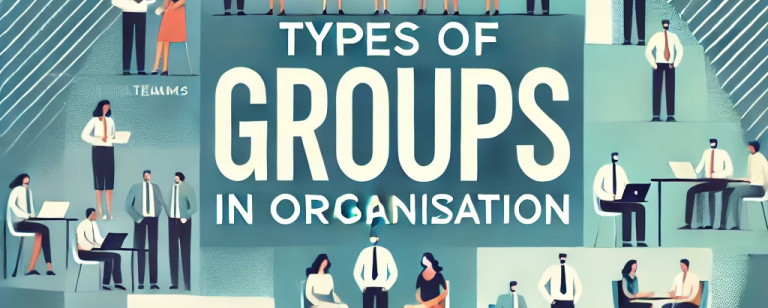Any organization must know the types of groups in organisation to improve productivity and teamwork. A group is a collection of people brought together to accomplish specific objectives. Groups can be classified into different categories depending on their formation, purpose, and structure. This article explains the major types of groups in organizations, including formal and informal groups. Groups consist of individuals who come together to achieve common goals, and they can be classified in various ways based on their formation, purpose, and structure. This article delves into the primary types of groups in organizations, focusing on the differences between formal and informal groups, their characteristics, and their impact on the workplace.
Meaning Of Group in Organisation
Groups in an organization refer to collections of individuals who come together to achieve specific goals or complete tasks. These groups can be formed formally or informally and play a crucial role in the functioning and success of the organization. An organization is a structured entity formed by individuals working together towards common goals or objectives.
Types of Groups in Organisation
In any organization, understanding the types of groups in organisation is essential for fostering collaboration and achieving common goals. Groups within an organization can be classified based on their formation, purpose, and structure. These groups, whether formal or informal, play a crucial role in driving productivity, innovation, and a positive work environment.
Formal Groups
Formal groups are structured and formed by organizations to help them meet specific purposes. Normally, these groups have a chain of command and defined roles and responsibilities. Members of formal groups know their duties and perform them to achieve the organization’s goals.
Characteristics of Formal Groups
Formal groups are characterized by certain differences from informal groups.
- Purpose. Organizations form them to accomplish specific tasks or projects.
- Members have roles. Everyone has specific duties that correspond to their skills and the goals of the group.Formal groups usually have defined communication channels.
Types of Formal Groups
Formal groups can be classified into several categories:
- Command Groups: These groups include members who report to a manager. The manager controls their activities and ensures they accomplish their tasks efficiently.
- Task Groups: Task groups form to complete a specific project or task. Once they have accomplished their goal, these groups usually dissolve.
- Functional Groups: These groups consist of people coming from the same department or function. For example, a marketing team or a finance team works towards departmental objectives.
- Cross-Functional Groups: These groups comprise members coming from different departments. They work on projects that demand varied skills and views.
Advantages of Formal Groups
- Clarity in Roles: The roles are clear for members, hence reducing confusion.
- Structured Communication: Formal channels aid in proper communication without any distortion. Such groups have specific objectives that are better accomplished.
Disadvantages of Formal Groups
- Rigidity: The formal groups find it difficult to change rapidly with the times.
- Bureaucracy: The already existing hierarchy tends to delay decision-making.
Informal Groups
Informal groups are formed naturally within an organization and are not officially established. They are formed based on common interests or social connections. Members interact freely, often outside the formal boundaries of the organization.
Characteristics of Informal Groups
Informal groups have some peculiar characteristics.
- Interpersonal Relationship: informal groups are created based on interpersonal relationships. Individuals connect with one another over a common interest, hobby, or experience.
- Structure: Informal groups do not have an overall structure. Individuals do not have designated roles to play
Types of Informal Groups
Informal groups can adopt many different forms:
- Friendship Groups: In this group, members are usually those with personal ties. They share social and psychological support.
- Interest Groups: This group mainly involves people who come together due to shared interests. It could be interest in sports, book clubs, etc.
- Support Groups: This group helps individuals with issues such as psychological stress or difficulties at work.
Advantages of Informal Groups
- Flexibility: Informal groups are usually flexible when change or ideas come along.
- Improved Communication: Open communication allows members to trust each other and grow in their relationship. Members are normally creative and innovative in ideas without any formality in structures.
Disadvantages of Informal Groups
- Lack of Clarity: The members might not know their contribution without clearly defined roles.
- Potential for Conflict: Personal relationships can lead to misunderstandings or conflicts.
Comparison Between Formal and Informal Groups
Understanding the key differences between formal and informal groups helps organizations leverage their strengths. Below is a table comparing the two types:
| Feature | Formal Groups | Informal Groups |
| Structure | Clearly defined roles and hierarchy | Loose structure, based on personal ties |
| Purpose | Achieving specific organizational goals | Social interaction and support |
| Communication | Follows official channels | Open and casual |
| Adaptability | Less flexible | Highly adaptable |
| Conflict Potential | Limited to organizational goals | May arise from personal relationships |
Types of Groups in Organisation FAQs
What are the main types of groups in organizations?
The main types include formal groups, which are structured and goal-oriented, and informal groups, which form naturally based on personal relationships and social connections.
What is the purpose of formal groups?
Formal groups aim to achieve specific objectives set by the organization. They help streamline tasks and ensure that everyone understands their roles and responsibilities.
How do informal groups benefit an organization?
Informal groups foster open communication, enhance relationships among employees, and encourage creativity. They can also provide emotional support and improve morale.
Can informal groups influence formal groups?
Yes, informal groups can significantly influence formal groups. They often shape organizational culture and can affect decision-making processes through shared ideas and informal networks.
What are some challenges of managing formal groups?
Challenges of managing formal groups include potential bureaucracy, limited flexibility, and the risk of conflict between departments or team members with differing goals.


